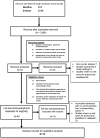Clinical risk scores for predicting stroke-associated pneumonia: A systematic review
- PMID: 31008268
- PMCID: PMC6301233
- DOI: 10.1177/2396987316651759
Clinical risk scores for predicting stroke-associated pneumonia: A systematic review
Abstract
Purpose: Several risk stratification scores for predicting stroke-associated pneumonia have been derived. We aimed to evaluate the performance and clinical usefulness of such scores for predicting stroke-associated pneumonia.
Method: A systematic literature review was undertaken in accordance with the Preferred Reporting Items for Systematic Reviews and Meta-Analyses statement, with application of the Quality Assessment of Diagnostic Accuracy-2 tool. Published studies of hospitalised adults with ischaemic stroke, intracerebral haemorrhage, or both, which derived and validated an integer-based clinical risk score, or externally validated an existing score to predict occurrence of stroke-associated pneumonia, were considered and independently screened for inclusion by two reviewers.
Findings: We identified nine scores, from eight derivation cohorts. Age was a component of all scores, and the NIHSS score in all except one. Six scores were internally validated and five scores were externally validated. The A2DS2 score (Age, Atrial fibrillation, Dysphagia, Severity [NIHSS], Sex) was the most externally validated in 8 independent cohorts. Performance measures were reported for eight scores. Discrimination tended to be more variable in the external validation cohorts (C statistic 0.67-0.83) than the derivation cohorts (C statistic 0.74-0.85).
Discussion: Overall, discrimination and calibration were similar between the different scores. No study evaluated influence on clinical decision making or prognosis.
Conclusion: The clinical prediction scores varied in their simplicity of use and were comparable in performance. Utility of such scores for preventive intervention trials and in clinical practice remains uncertain and requires further study.
Keywords: intracerebral haemorrhage; ischaemic stroke; pneumonia; risk score.
Conflict of interest statement
The author(s) declared the following potential conflicts of interest with respect to the research, authorship, and/or publication of this article: CJS, BB, PJT and AM have all co-authored derivation/validation studies of the ISAN and A2DS2 scores included in this systematic review. AM is a co-inventor and co-owner of a patent on anti-infective agents and immunomodulators used for preventative therapy following an acute cerebrovascular accident has been filed to the European Patent Office (PCT/EP03/02246). AKK, AV, AC, MDN, LK, PL, JM, CR, AGR, DvdB and MW declare no conflicts of interest or disclosures.
Figures
References
-
- Katzan IL, Cebul RD, Husak SH, et al. The effect of pneumonia on mortality among patients hospitalized for acute stroke. Neurology 2003; 60: 620–625. - PubMed
-
- Finlayson O, Kapral M, Hall R, et al. on behalf of the Investigators of the Registry of the Canadian Stroke Network. Risk factors, inpatient care, and outcomes of pneumonia after ischemic stroke. Neurology 2011; 77: 1338–1345. - PubMed
-
- Katzan IL, Dawson NV, Thomas CL, et al. The cost of pneumonia after acute stroke. Neurology 2007; 68: 1938–1943. - PubMed
-
- Koennecke HC, Belz W, Berfelde D, et al. for the Berlin Stroke Register Investigators. Factors influencing in-hospital mortality and morbidity inpatients treated on a stroke unit. Neurology 2011; 77: 965–972. - PubMed
Publication types
LinkOut - more resources
Full Text Sources


